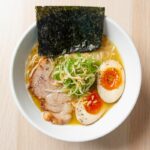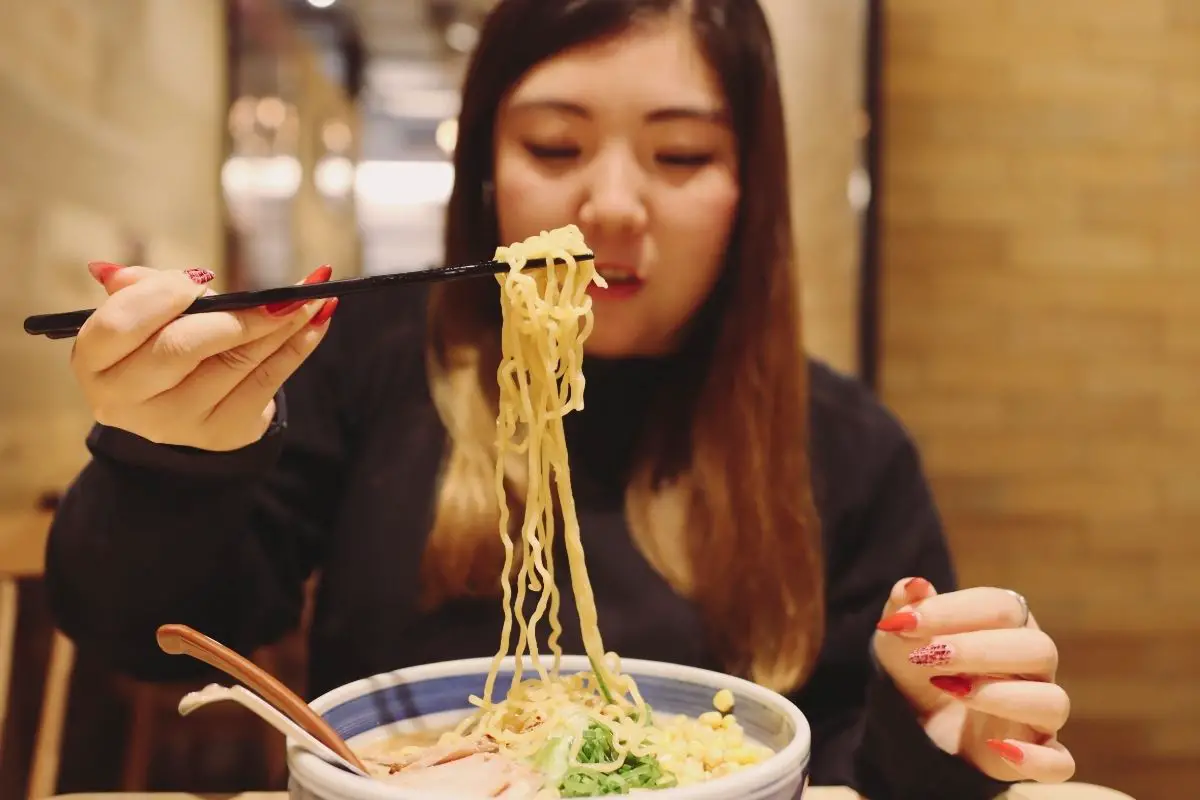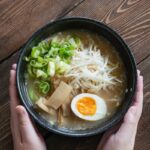Ramen is a Japanese noodle dish that was most likely influenced by Chinese noodle dishes. It is a staple food of Japan and enjoyed by many people worldwide in Japanese restaurants.
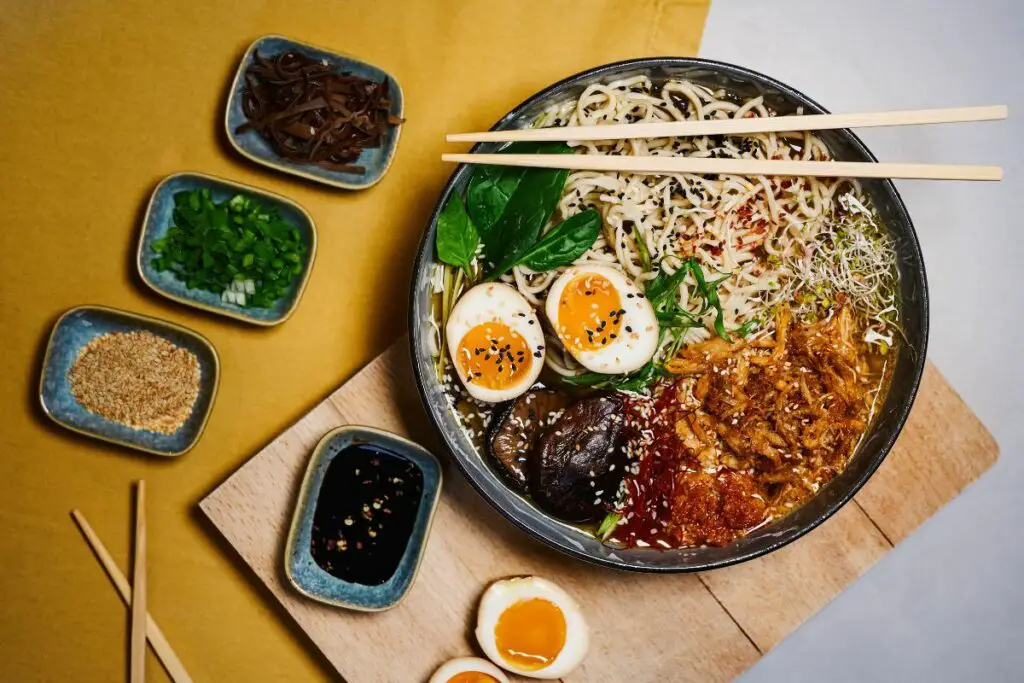
But have you ever considered how many calories there are in ramen? We will take a look at the different types of ramen and what their calorific values are.
Types Of Ramen
There are four main types of ramen, each of which is determined by its base flavor. Shio is salt based ramen, shoyu is soy sauce based, miso is soybean paste flavored and tonkotsu is pork bone broth ramen.
With each of these basic types of ramen there are also many regional variations with different toppings added to them. But one thing is common to all types of ramen, the noodles.
Ramen noodles are made from wheat flour, water, salt and kansui. Kansui is a type of alkaline water that has sodium carbonate and potassium carbonate. This is what gives ramen their distinctive firmness, flavor and unique yellow color.
The thickness of the noodles depends on the type of ramen. Shoyu ramen has thin noodles whereas kitakata ramen has really thick noodles.
How Many Calories In Ramen?
Most of the calories in ramen come from the noodles themselves. The amount of noodles as well as the thickness will alter the calorie input. With the long list of ingredients that can be added to ramen there are many things that can increase the calorific value.
Chashu or thinly sliced pork belly will add fat to a ramen dish as will kakumi which is braised pork cubes. Some ramens also include butter which will add to its richness.
However, the majority of added ingredients are relatively low in calories. Fermented bamboo shoots, boiled eggs, corn and green onions will add mid to low amounts of calories to the ramen.
Nutritional Value Of Ramen
There are important nutrients which you can obtain from ramen. Protein from meat such as pork and chicken as well as from the noodles. You will also get some carbohydrates from the noodles.
The amount of fat that you will get from ramen depends on the individual dish. Some ramens have fatty pork, such as pork belly added while others include butter in their ingredients.
Clear broth ramen such as shio ramen which has a light, chicken broth base is lower in calories, although it is higher in salt than some other ramens. Tonkotsu is perhaps the most indulgent ramen with a thick, creamy broth and lots of toppings.
There are not a lot of vitamins in ramen as the amount of vegetables is minimal. It lacks vitamins A, D, E and K since they are fat soluble and vitamin C as it is affected by heat.
Shoyu Ramen
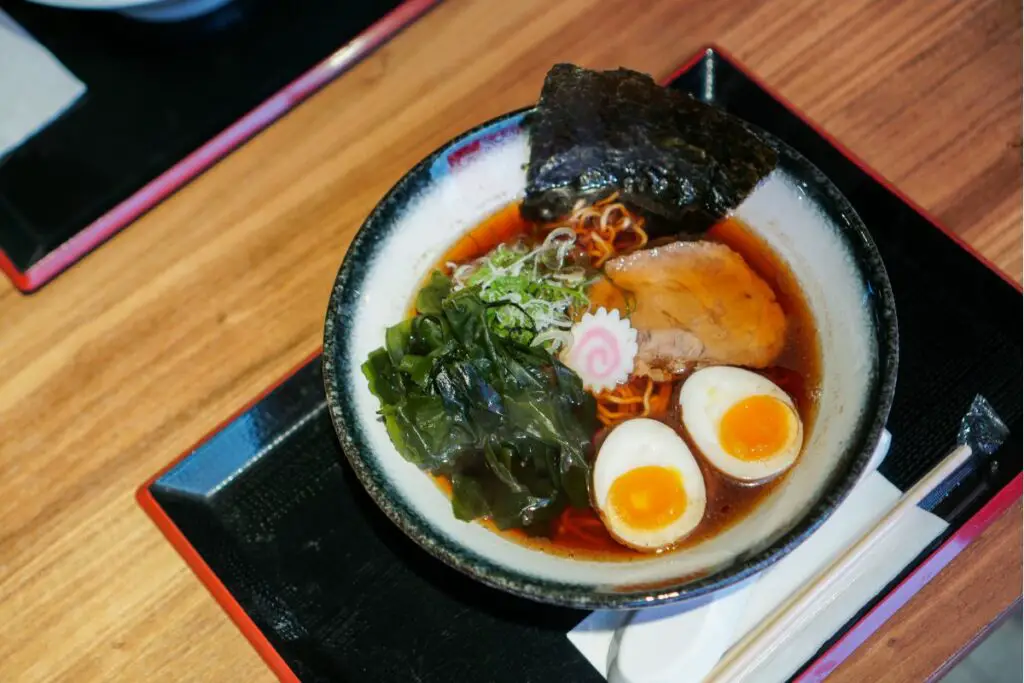
Shoyu ramen originated in Tokyo and was originally called Tokyo ramen. It is actually one of the lowest in terms of calorie intake. Of course, as with other ramens the calorific value depends on the toppings added to the ramen.
Shoyu is a more neutral type of ramen as it is not creamy or thick and gets most of its flavor from the soy sauce which is added to the clear chicken broth. To add some more substance, wheat noodles, sliced egg, pork, or fish cakes are sometimes put into the ramen.
A bowl of shoyu ramen has between 470–700 calories depending on how many noodles and other ingredients are added to it.
Miso Ramen
Miso ramen originated in the northernmost prefecture of Japan, Hokkaido. This is more of a hearty ramen being richer and more complex than shoyu ramen. The addition of fermented soybean paste makes it a heavier dish.
Again the calorific value depends on the amount of meat and noodles added to the miso ramen. For 100 grams of noodles and around 2 ounces of fatty meat a bowl of miso ramen will have about 800 calories.
Less fatty meat and fewer noodles will reduce the amount of calories in miso ramen. However, the base is fermented soybean paste which adds calories to the dish.
The history of miso ramen demonstrates the necessity of high calorific values. It originated in the post WW2 era when Japan was rebuilding its country and the people needed good nutrition.
Tonkotsu Ramen
Tonkotsu ramen originated in Hakata which is modern day Fukuoka in the south of Japan. This ramen is recognized by its beige color which comes from boiling pork bones for a long time. The resulting melted fat, gelatin and marrow creates the broth.
As a result, tonkotsu ramen is one of the most calorie dense and fattiest of all ramens. A full bowl of this ramen can provide between 900–1240 calories. The addition of toppings such as pork belly, pork shoulder or fish cakes add to the indulgence of this ramen.
Of course, the noodles are also added to the dish and this further increases the calorie count. However, a regular portion of ramen noodles in Japan is only around 130–180 grams before they are cooked.
Shio Ramen
Shio ramen is so called as it is a salt based with shio being the Japanese word for salt. It has a lighter chicken or pork broth base but as it is salt based it is higher in sodium than other ramens.
However, it doesn’t have the level of animal fat that gives tonkotsu its richness, so it is slightly lower in calories. Nor does it have the thicker broth of miso that comes from the fermented soybean paste with its nutritional density.
Having said that, shio ramen will still provide between 460–700 calories depending on what is added to it including the amount of noodles. The flavor of shio ramen comes from the addition of wakame, shiitake, kombu, and dashi to ensure it tastes of more than just salt.
Final Thoughts
We hope you have enjoyed our guide to how many calories are in ramen and that it has been informative for you.

